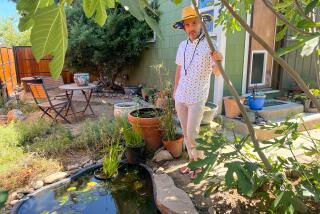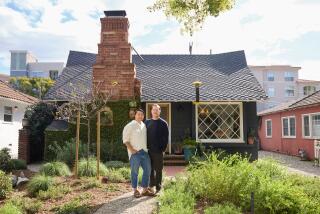Small-Space Water Wonderland
You’ve always dreamed of having a water garden--a shimmering pond in an idyllic, tranquil spot in your back yard, filled with beautiful, exotic aquatic plants and colorful fish swimming lazily about.
The problem is, you don’t have a back yard because you live in an apartment or condominium.
Well, thanks to tub gardens, if you have a sunny patio or balcony, you can have that fabulous water garden of your dreams.
“Not everyone is blessed with a large gardening area,” said William C. Uber, president of the family-owned Van Ness Water Gardens in Upland. “Tub gardens are the answer for apartment and condo dwellers who want to experience the joys of water gardening, since they can be created in the same size space it takes for a large planter or barbecue grill.”
“Children find these miniature water kingdoms fascinating, as well as adults,” said Uber, who has been an avid water gardener since his own early childhood and whose family began their business in 1932. “Kids get a big kick out of watching the aquatic plants grow and blossom, the progress of the water snails and the care and feeding of the small tub fish.”
To create a tub garden of your own, begin by picking a spot on a balcony or patio that gets at least four hours of sun a day.
Next get a container appropriate for the size of the spot where your tub garden will sit. Your tub should hold at least four gallons and should be completely sealed. Ceramic pots, old crocks, even wash tubs make excellent tub gardens, as do wine, whiskey and olive half-barrels.
The best way to buy a barrel, according to Bill Dimino, owner of Oakwood Fountain and Ponds in Venice, is to call your building supply store and find out when their supply of barrels is coming in.
“The trick is to select your barrel as soon as possible after they come in,” said Domino, who began tub gardening in 1979. “That way, the staves will still be tightly together whereas after a few days they begin to dry up and separate.”
Barrels are cured with charcoal, Dimino said, thus they usually contain bacteria that are harmful to plants and fish, so they should be scraped out at once and filled with water immediately. You might even want to line your barrel with a sheet of polyvinylchloride (PVC) to be absolutely safe.
Once your tub is filled with water, add a chemical chloramine remover such as “Quick Start.” Now it’s time to begin planting the aquatic plants you’ve chosen.
Aquatic plants are far different from terrestrial plants, which would rot if placed in a water garden, so it’s vital you purchase your plant material from an aquatic plant specialist. There aren’t very many retailers of aquatic plants, so buying plants from a catalogue is probably the easiest and most satisfying way to go.
If you can’t get to the Van Ness Water Gardens, which are open Tuesday through Saturday, their catalogue is excellent, filled with beautiful photographs and extensive information on water gardening in general. It’s available for $2 from Van Ness Water Gardens, 2460 N. Euclid Ave., Upland, Calif. 91786-1199, telephone (909) 982-2425.
Another excellent catalogue is available free from Lilypons Water Gardens, 6800 Lilypons Road, P.O. Box 10, Buckeystown, Md. 21717-0010, telephone (800) 365-5459. It, too, is beautifully produced with lots of color photos and water gardening information.
Dimino’s Oakwood Fountains and Ponds specializes in bog plants that have been adapted especially for tub gardening and also sells barrels that have been cleaned and sealed and are ready for planting. Call (310) 399-8256 for further information.
Any good water-gardening catalogue will offer you a large variety of colorful and exciting aquatic plant material, which will come to you in air-tight plastic bags. The plants available are basically divided into three types:
The most familiar type is the floating plant, which includes water lilies. These plants sit on the surface of the pond and produce endless blossoms in a vast array of colors including red, white, pink, yellow, and purple. Miniatures are better in tubs than the full-size water lilies, which require larger surface areas to do their best. All need full sun to bloom.
A second group of aquatic plants are the small flowering ornamentals, which rise about 6 inches above the surface. This group includes pennywort, parrot’s feather and water hyacinths.
And finally there are the bog plants, which range in height from 18 inches all the way up to about four feet. These include iris, various grasses and the familiar cat-tails.
At the same time you buy your plants, also buy a corresponding number of pulp planters, also available in the better water gardening catalogues. Do not use plastic or ceramic pots. “Pulp is the proper medium for the pots,” said Uber, “because that way, when the plant becomes root-bound, it can exchange gasses and nutrients with the water.”
Once your pond is filled and you’re ready to begin planting, fill up your pulp pots with garden topsoil, blocking the holes in the bottom of the pots with newspaper and covering the soil with a layer of sand or pebbles to keep it from spilling out into the water. Do not use commercial mixes or potting soil, since these materials are treated with herbicide, which would kill aquatic plants. If you live in an apartment or condo, topsoil is available at most nurseries or home centers.
Next, wet the soil thoroughly and then, working quickly, remove the plants from the plastic bags and plant them. You must work fast. Aquatic plants will be severely injured if their roots are exposed for too long. Once planted, slowly lower each container into your tub. If the plants are too deep, prop up the containers with rocks or bricks.
The next steps are adding marine life to your tub. Water snails, available through catalogues or certain aquarium stores, should be added to eat the algae, which is weed and will compete with the plants for nutrients.
And, of course, you’ll want to have fish. Tub gardens are susceptible to extremes in temperatures, which is detrimental to fish, so it’s best to keep your water temperature at about 75 degrees using a regular aquarium heater. If you have a heater, feeder goldfish are fine, but without a heater mosquito fish or guppies are recommended.
As your tub garden begins to mature, you might notice a greenish tone to the water. This is merely the tub garden going through a transition period, during which time about 15% of the water should be replaced every day or two with fresh water until the pond stabilizes and reaches its proper balance, which should be in about 30 to 60 days. (Dip the water out of the tub garden with a coffee can, and use that water on your houseplants. It’s full of nutrients and free of salt.) Put in the new water slowly to help break down the chloramines.
As far as maintenance of your tub garden is concerned, Uber says that biggest problem is people fooling around. “Leave things alone,” he said,, “except about a year down the line add a bit of aquatic fertilizer according to the package directions.”
Actually, Uber said, even if you have a back yard and are planning to build a large water garden you should begin with a tub garden to get the feel of water gardening. “My happiest customers are those who start with tubs,” he said.






